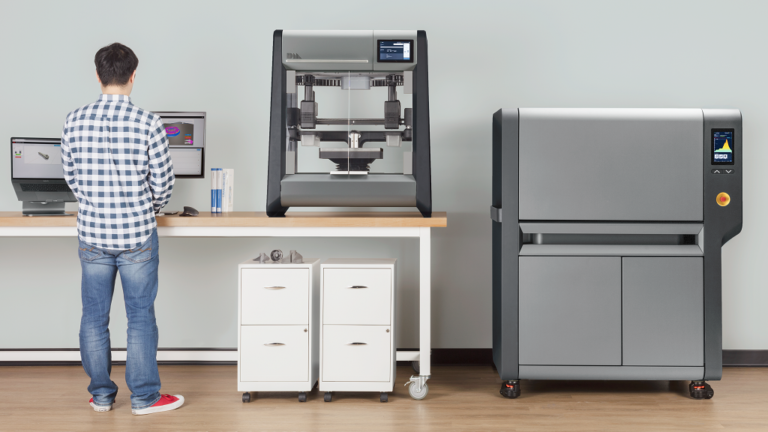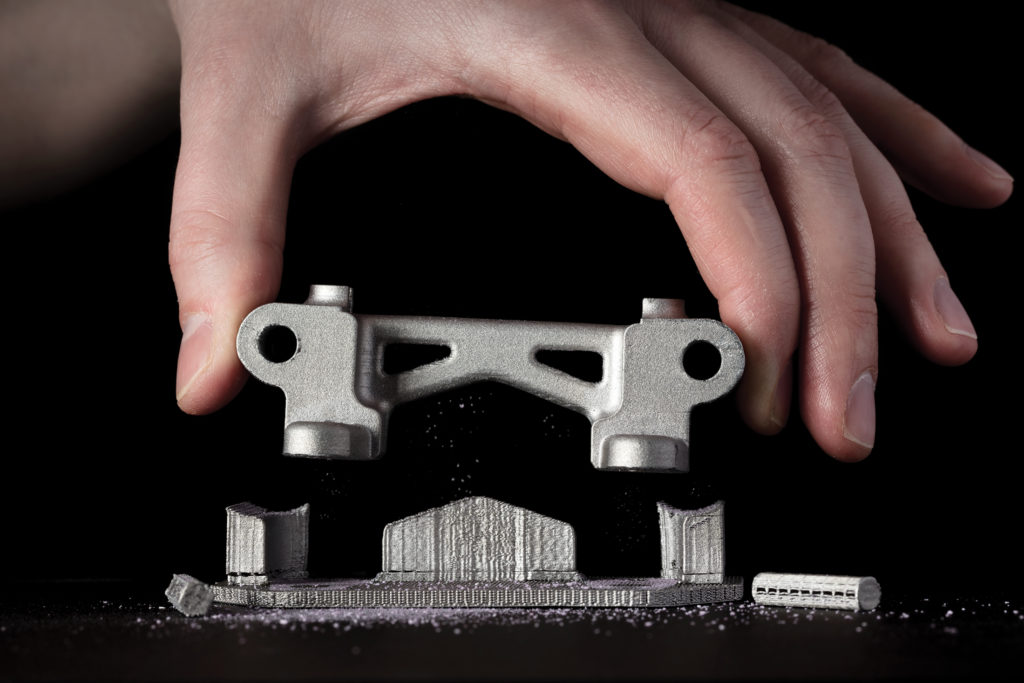When a privately held startup hits $1 billion in value, it magically transforms from an ugly mare into a beautiful unicorn (or so the legend goes). In the 3D printing space, there are three such creatures and we’ll be profiling each one. This time, we’ll be taking a look at Desktop Metal.
Based in Cambridge, Mass., Desktop Metal was founded in October 2015 with the goal of introducing (comparatively) low-cost, easy-to-use, office-safe metal 3D printing to the world of production. From then until April of 2017, that was just about all that was known to the public about the new startup. Behind closed doors, however, the company was making rounds with some very large investors, raising nearly $100 million in Series A through C funding rounds that included GE Ventures, Saudi Aramco Energy Ventures, BMW iVentures and Lowe’s Ventures.
Though the first product wasn’t announced until the spring of 2017, investors may have partially been confident about the firm’s leadership team. Desktop Metal was founded by Ric Fulop and six others, mostly hailing from SolidWorks and MIT. Fulop himself was a general partner at North Bridge, leading Series A investments in Onshape and Markforged. Northbridge itself was involved in the Series A funding rounds of numerous successful startups ultimately acquired by larger companies, such as Revit, SolidWorks and SpaceClaim, bought out by Autodesk, Dassault, and Ansys respectively. With his previous firm, A123 Systems, Fulop commercialized technology developed at MIT and left it with a market cap of $1.5 billion (the firm later went bankrupt).
When it finally did show its hand, Desktop Metal revealed not one but two 3D printing systems: the Studio System and the Production System. The former is a desktop machine that uses a process called Bound Metal Deposition (BMD) to 3D print green parts made from metal powder bound within a plastic matrix. Once printed, the green part is placed in a furnace that burns out the binder, leaving a dense metal part. Support structures are easily removed by hand, no loose powder is ever exposed to the user, and no lasers are involved, making it suitable for office use, according to the company. The required debinding and sintering steps, however, would be difficult to do safely in most offices.
The Production System uses a binder jetting process called Single Pass Jetting (SPJ) in which a binding agent is deposited onto metal powder. It distinguishes itself from technology used by ExOne in that it performs all of the necessary print steps—spreading metal powder, compacting it and depositing binder—in a single pass before reversing direction and printing another layer. During the printing process, “anti sintering agents” are also deposited, making post-processing easier and cheaper. Once complete, the green part or parts are sintered in a microwave furnace.
Because SJP isn’t wasting time compacting powder with a separate recoating process, the technology reaches speeds of up to four times faster than other binder jetting processes. At Formnext 2018, Desktop Metal announced improvements in its Production System that included a print speed increase of 50 percent and a 225 percent increase in build volume to 750 x 330 x 250 mm.
Both systems rely on metal powder from the metal injection molding (MIM) industry, meaning that there is a potentially much greater supply of materials available for these printers than traditional metal 3D printers. Several hundred alloy types are tentatively printable, though each requires testing before they are officially released by the company. Both systems also cost less than $500,000, with the Studio running for $120,000 and the Production running for $360,000 at the time of release, without the additional equipment included.
Desktop Metal began shipping its Studio Systems at the end of 2017 and delivered its first Production System at the beginning of 2019. Reportedly the firm has had difficulty delivering systems and customers have had issues making parts on the systems. Since then, it has not only announced additional materials, but 3D printing processes as well.
Ahead of Formnext 2019, the startup unveiled its Fiber platform, a desktop version of automatic fiber placement. Desktop Metal’s micro automated fiber replacement (μAFP) uses two print heads, one for 3D printing thermoplastic and another for laying down fiber reinforcement tape.
Here it’s worth noting that Desktop Metal has troubled history with Markforged, which was the first to market with a carbon fiber 3D printer. As previously mentioned, Fulop sat on the board of Markforged before launching his own 3D printing startup. While the μAFP process offers a distinct take on reinforcement fiber printing, it is notable that a company called Desktop Metal would develop a polymer fiber printing process. BMD meanwhile bears a striking similarity to a technology developed by Markforged called atomic diffusion additive manufacturing (ADAM).
Both machines print parts using metal infused in a thermoplastic matrix that are then sintered in a furnace to create a fully dense metal part. Desktop Metal first sued Markforged for patent infringement and lost with Markforged launching a countersuit that ended in settlement. Desktop Metal agreed to refrain from disparaging ADAM or face a $100,000 penalty. Markforged then sued again, claiming that Desktop Metal handed out promo materials disparaging its products to over one hundred of its resellers, which would incur a $100,000 fine in each instance. This most recent suit was made public in July 2019 and news of its resolution has not yet been released.
The unicorn continues onward. In its latest and largest funding round (led by Koch Industries), in January 2019, Desktop Metal raised $160 million, bringing its total raised to $438 million. It has also developed a software called Live Parts, designed to automatically generate printable designs. Most recently, at Formnext 2019, the firm introduced its Shop System, a SJP printer that fits between the Studio and Production Systems. With general availability expected in fall 2020, the 4L version (350 x 220 x 50mm) comes in at $150,000, while the 16L (350 x 220 x 200mm) comes in at $225,000.
Out of all three of our 3D printing unicorns, Desktop Metal is the newest, which means that it has also had the least amount of time on the market, which means that its valuation of over $1.2 billion is perhaps the most based on speculation and least on real-world performance. For some tech unicorns in the past, this has only led to proof that unicorns don’t actually exist. For Desktop Metal, we will have to see if their systems actually do make the production of metal 3D-printed parts as easy, safe and cheap as promised.
Join the discussion of this and other 3D printing topics at 3DPrintBoard.com.
Subscribe to Our Email Newsletter
Stay up-to-date on all the latest news from the 3D printing industry and receive information and offers from third party vendors.
Print Services
Upload your 3D Models and get them printed quickly and efficiently.
You May Also Like
Reinventing Reindustrialization: Why NAVWAR Project Manager Spencer Koroly Invented a Made-in-America 3D Printer
It has become virtually impossible to regularly follow additive manufacturing (AM) industry news and not stumble across the term “defense industrial base” (DIB), a concept encompassing all the many diverse...
Inside The Barnes Global Advisors’ Vision for a Stronger AM Ecosystem
As additive manufacturing (AM) continues to revolutionize the industrial landscape, Pittsburgh-based consultancy The Barnes Global Advisors (TBGA) is helping shape what that future looks like. As the largest independent AM...
Ruggedized: How USMC Innovation Officer Matt Pine Navigates 3D Printing in the Military
Disclaimer: Matt Pine’s views are not the views of the Department of Defense nor the U.S. Marine Corps Throughout this decade thus far, the military’s adoption of additive manufacturing (AM)...
U.S. Congress Calls Out 3D Printing in Proposal for Commercial Reserve Manufacturing Network
Last week, the U.S. House of Representatives’ Appropriations Committee moved the FY 2026 defense bill forward to the House floor. Included in the legislation is a $131 million proposal for...




































